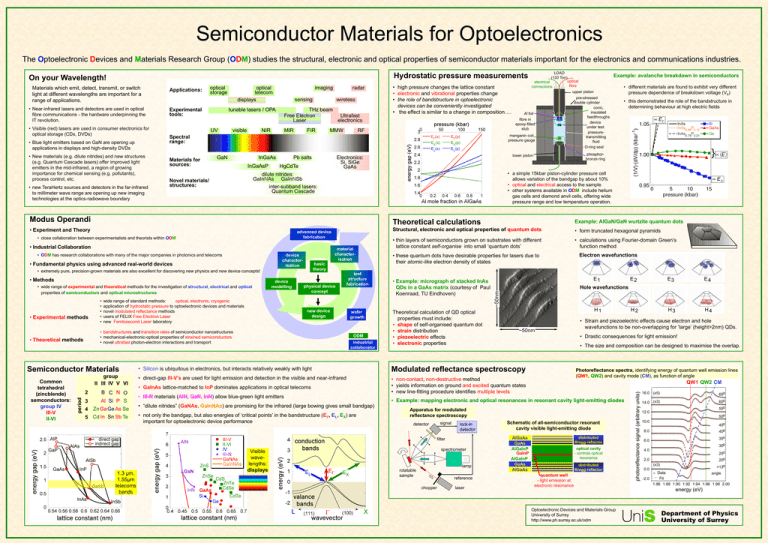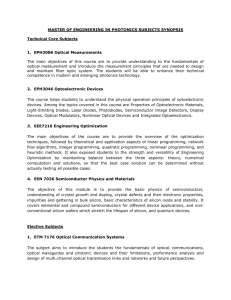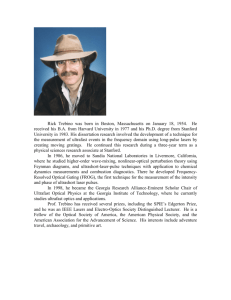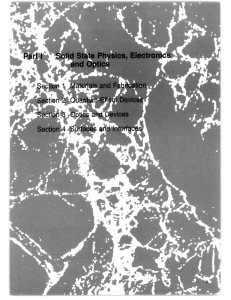UniSMatODM - University of Surrey
advertisement

Semiconductor Materials for Optoelectronics The Optoelectronic Devices and Materials Research Group (ODM) studies the structural, electronic and optical properties of semiconductor materials important for the electronics and communications industries. Hydrostatic pressure measurements On your Wavelength! Applications: • Near-infrared lasers and detectors are used in optical fibre communications - the hardware underpinning the IT revolution. Experimental tools: • Blue light emitters based on GaN are opening up applications in displays and high-density DVDs • New materials (e.g. dilute nitrides) and new structures (e.g. Quantum Cascade lasers) offer improved light emitters in the mid-infrared, a region of growing importance for chemical sensing (e.g. pollutants), process control, etc. • new TeraHertz sources and detectors in the far-infrared to millimeter wave range are opening up new imaging technologies at the optics-radiowave boundary optical telecom displays imaging sensing tunable lasers / OPA UV visible radar wireless THz beam Free Electron Ultrafast Laser electronics NIR MIR FIR MMW manganin coil pressure gauge Spectral range: Materials for sources: GaN InGaAs InGaAsP Pb salts advanced device fabrication • close collaboration between experimentalists and theorists within ODM • Industrial Collaboration • ODM has research collaborations with many of the major companies in photonics and telecoms material characterisation device characterisation • Fundamental physics using advanced real-world devices basic theory • extremely pure, precision-grown materials are also excellent for discovering new physics and new device concepts! • Methods • wide range of experimental and theoretical methods for the investigation of structural, electrical and optical properties of semiconductors and optical microstructures wide range of standard methods: optical, electronic, cryogenic application of hydrostatic pressure to optoelectronic devices and materials novel modulated reflectance methods users of FELIX Free Electron Laser new Femtosecond Laser laboratory Semiconductor Materials group II III IV V VI period physical device concept new device design • bandstructures and transition rates of semiconductor nanostructures • mechanical-electronic-optical properties of strained semiconductors • novel ultrafast photon-electron interactions and transport • Theoretical methods Common tetrahedral (zincblende) semconductors: group IV III-V II-VI device modelling 2 B C N O 3 Al Si P S 4 Zn Ga Ge As Se 5 Cd In Sn Sb Te test structure fabrication wafer growth ODM industrial collaborator Example: AlGaN/GaN wurtzite quantum dots Structural, electronic and optical properties of quantum dots • form truncated hexagonal pyramids • thin layers of semiconductors grown on substrates with different lattice constant self-organise into small ‘quantum dots’ • calculations using Fourier-domain Green’s function method • these quantum dots have desirable properties for lasers due to their atomic-like electron density of states • Example: micrograph of stacked InAs QDs in a GaAs matrix (courtesy of Paul Koenraad, TU Eindhoven) Theoretical calculation of QD optical properties must include: • shape of self-organised quantum dot • strain distribution • piezoelectric effects • electronic properties H1 ~50nm • “dilute nitrides” (GaNAs, GaInNAs) are promising for the infrared (large bowing gives small bandgap) • not only the bandgap, but also energies of ‘critical points’ in the bandstructure (EG, EL, EX) are important for optoelectronic device performance lock-in detector spectrometer lamp rotatable sample reference chopper laser H2 H3 H4 • The size and composition can be designed to maximise the overlap. Photoreflectance spectra, identifying energy of quantum well emission lines (QW1, QW2) and cavity mode (CM), as function of angle QW1 QW2 CM Apparatus for modulated reflectance spectroscopy signal E4 • Strain and piezoelectric effects cause electron and hole wavefunctions to be non-overlapping for ‘large’ (height>2nm) QDs. • Example: mapping electronic and optical resonances in resonant cavity light-emitting diodes detector E3 • Drastic consequences for light emission! • non-contact, non-destructive method • yields information on ground and excited quantum states • new line-fitting procedure identifies multiple levels • III-N materials (AlN, GaN, InN) allow blue-green light emitters E2 Hole wavefunctions • direct-gap III-V’s are used for light emission and detection in the visible and near-infrared • GaInAs lattice-matched to InP dominates applications in optical telecoms Electron wavefunctions E1 Modulated reflectance spectroscopy filter 1.3 µm, 1.55µm telecoms bands • this demonstrated the role of the bandstructure in determining behaviour at high electric fields Theoretical calculations • Silicon is ubiquitous in electronics, but interacts relatively weakly with light Visible wavelengths: displays pre-stressed double cylinder conic, insulated feedthroughs device under test pressuretransmitting fluid O-ring seal • a simple 15kbar piston-cylinder pressure cell allows variation of the bandgap by about 10% • optical and electrical access to the sample • other systems available in ODM include helium gas cells and diamond anvil cells, offering wide pressure range and low temperature operation. dilute nitrides: GaInNAs GaInNSb inter-subband lasers: Quantum Cascade Novel materials/ structures: • different materials are found to exhibit very different pressure dependence of breakdown voltage (Vb) phosphorbronze ring lower piston Electronics: Si, SiGe GaAs HgCdTe • Experiment and Theory • Experimental methods Al foil fibre in epoxy-filled stub RF Modus Operandi • • • • • • high pressure changes the lattice constant • electronic and vibrational properties change • the role of bandstructure in optoelectronic devices can be conveniently investigated • the effect is similar to a change in composition…. ~50nm • Visible (red) lasers are used in consumer electronics for optical storage (CDs, DVDs) optical storage Example: avalanche breakdown in semiconductors Schematic of all-semiconductor resonant cavity visible light-emitting diode distributed Bragg reflector AlGaAs GaAs AlGaInP GaInP AlGaInP GaAs AlGaAs optical cavity - controls optical resonance distributed Bragg reflector quantum well - light emission at electronic resonance Optoelectronic Devices and Materials Group University of Surrey http://www.ph.surrey.ac.uk/odm photoreflectance signal (arbitrary units) Materials which emit, detect, transmit, or switch light at different wavelengths are important for a range of applications. LOAD (120 Ton) optical electrical fibre connections upper piston 16.0 (x5) 65o 14.0 (x3) 60o 55o 12.0 50o 10.0 45o 40o 8.0 35o 6.0 30o 4.0 25o 20o 2.0 (x3) =13o 0.0 Data angle Fit -2.0 1.86 1.88 1.90 1.92 1.94 1.96 1.98 2.00 energy (eV)








